FIRST BLOOD, the free anniversary update for Steel Division: Normandy 44, will be available tomorrow (wooohooooo!) and will feature 2 new FREE divisions and unlock 2 ace models: Pierre Clostermann & Willy Kretzschmar.
Let’s focus today on one of the US Army‘s oldest division and without a doubt the most experienced one in the ETO, 1st Infantry Division “Big Red One“.
ORIGINS
The 1st Infantry Division was created in 1917 as part of the American Expeditionary Forces (AEF) sent in Europe to fight in WW1. Aside from American volunteers already integrated within the French Army (such as the Lafayette Escadrille, Lafayette Flying Corps, American Ambulance…), it was the first American unit to land in France, in June 1917. On October 21st, it was also the first American unit to see combat and suffer casualties. But for their first six months at the front, the untested Americans were mostly kept in reserve, training or fighting under French or British supervision. On May 28th, 1918, BRO was again the first American unit to be engaged independently and to bring the USA its first victory, at the battle of Cantigny. From then on, it took part in every action fought by the AEF, including the battle of Saint-Mihiel and the Argonne offensive, suffering about 20,000 casualties before the end of the war.
After the Armistice of November 18th, 1918, the “Big Red One” (BRO), as it was now known for its distinctive tactical insignia, entered Germany and took occupational duties near Coblenz.
![interwar-1[1]](https://eugensystems.com/wp-content/uploads/2018/02/interwar-11-300x158.jpg)
BRO horsemen entering Coblenz, November 1918 (Sources: First Division Museum)
In early 1940, with war raging in Europe, it was reorganized, reinforced with organic support units and the first Army division to undergo amphibious training.
BACK TO EUROPE
Shortly after the USA entered WW2 on December 1941, command of the division was given to Major-Gen. Terry de la Mesa Allen. His leadership style, informal, lax on military appearance but uncompromising regarding aggressiveness and combat performance, commanding from the front and sleeping on the ground like any private, soon got him the respect and even affection of his men. And for better or worse, shaped the division’s personality for most of the war.
As the Army‘s best-prepared division, BRO was once again the first combat formation of its size to be sent to the European ETO, arriving in Britain in August 1942. Garrisoned near Glasgow (Scotland), it intensified its amphibious training. While the men thought they were to immediately proceed with the liberation of mainland Europe, they were to have a completely different destination…
NORTH AFRICA
On October 26th, 1942, the division was loaded on boats and the convoy headed out to see, sailing toward North Africa. It was to take part in Operation Torch, the British-American landing in French Morocco & Algeria. As the main element of Center Task Force, BRO was reinforced with armors & Rangers and divided into two combat groups to take the city of Oran (Algeria’s second major city) into a pincer: Force Z, under Allen’s direct command, was to land East of the city, and Force Y under Brigadier-General Theodore Roosevelt Jr. (son of US President Theodore Roosevelt and cousin of then serving President Franklin D. Roosevelt) was to land West of it.
The landing took place on November 8th just before 1 AM and in a matter of minutes the beaches were secured, the French coastal defenses being taken completely by surprise: most of the troops were asleep or, for those in position to resist, without clear order about what to do against American invaders. Very few local commanders took upon themselves to order to open fire, unlike what happened in Morocco where Vichy commanders had been aware of the impending landings and had given clear orders to resist.
With French Morocco & Algeria secured and the Vichy Armée d’Afrique siding with the Allies, BRO left Oran and moved West, toward Tunisia. There, Rommel’s once invincible DAK was soon to be cornered between the British, American & French troops attacking from the West, and the British & Commonwealth ones advancing from the East in the wake of their victory at El Alamein.
BATTLES OF KASSERINE PASS & EL GUETTAR
Having received reinforcements in Tunisia, Rommel planned to attack the Americans first, whom he considered inexperienced, in order to rout them and thus have enough time to turn against his most dangerous foe: Montgomery’s battle-hardened Eighth Army. Therefore, he laid a trap for the American vanguard, composed of the 1st Armored Division supported by infantry combat groups from BRO & 34th Infantry Division. In the issuing series of engagements fought between February 19th & 24th, 1943, and known collectively as the “battle of Kasserine Pass“, the overconfident & overextended Americans were graced with a full display of German Panzer skill: while having a slight advantage in numbers, the former suffered about five times the losses in tanks & men they inflicted on the latter, and had to beat a hasty retreat. Although he would have liked to pursue and finish them off, Rommel was confident he had accomplished his objective: teaching the Americans a lesson he was sure would take them long to recover, long enough for him to deal with his British arch-enemy.
But as Winston Churchill once put it: “You can always count on Americans to do the right thing – after they’ve tried everything else“. And at Kasserine, the Americans almost tried everything that could have gone (and went) wrong at once: bad leadership, bad communications, bad combined arms cooperation, overconfidence, overextended supply lines, … The disaster at Kasserine was the healthy electroshock the US Army needed to “do the right thing”: to shake old habits, devise new tactics and training procedures, put a stronger emphasis on commander’s initiative and replace WW1-minded officers with younger and more energic ones. As such, General Fredendall, commanding the US II. Corps during the battle was sent back home and replaced with George Patton with Omar Bradley as his deputy. Not only did it take a much shorter time for the Americans to recover from the lesson they had been inflicted by Rommel than the latter had expected, but they were soon to prove that they had actually been very studious pupils.
One month after Kasserine, the reorganized II. Corps under Patton & Bradley was on the offensive again, advancing toward Bizerte. Von Arnim, which had replaced Rommel, opted for the same strategy: a violent assault against the inexperienced Americans to put them out of combat quickly, then deal with the “real” British threat. On March 23rd, about 50 tanks and supporting infantry from 10. Panzerdivision emerged from El Guettar valley and assaulted BRO. The first American lines were pushed back far enough for Allen’s HQ to be threatened by two German tanks, but when advised to evacuate, the general replied: “I will like hell pull out, and I’ll shoot the first bastard who does“. BRO lines wavered … yet did not break. The Germans soon ran into a minefield, while US reinforcements were brought into action, especially M10 Wolverines which engaged the German tanks. Three hours after initiating the battle, the Germans retreated, abandoning more than half their tanks behind them. They launched another attack later in the day but were met with the same determined resistance. BRO had won the day.
The campaign lagged on for a more month before the last remaining Axis forces in Tunisia surrendered on May 9th, 1943. By then, BRO had established a reputation as a reliable and efficient fighting force in combat. Its off-combat record wasn’t as prestigious though, the whole division having, according to Bradley, “assumed Allen’s cavalier attitude” and “left a trail of looted wine shops and outraged mayors (…) in towns from Tunisia all the way to Arzew“. One particular incident saw elements from the division “liberating Oran a second time”, this time from the US Army‘s own Services of Supply which was by then well-established in the city and had thought wiser to close all their clubs and shops to the brawling and celebrating combat troops.
SICILY & ITALY
Both Patton & Bradley were very critical of Allen’s “casual” command style yet recognized him as a formidable leader of men nonetheless. But while the former wanted to keep him by his side whatever his flaws, the latter was poised at having him replaced. Allen’s days commanding BRO were now counted.
While planning the invasion of Sicily, Patton requested Allen and his division specifically to land at Gela which he had (correctly) identified as the operation’s toughest sector: “I want those sons of bitches. I won’t go without them!“. Hence BRO participated in its second amphibious assault, at Gela on July 10th, 1943. As Patton had surmised, they faced the strongest resistance, in the form of Italian & German armored counter-attacks. Immediately forced to the defensive, BRO held its beachhead for two days with support from naval artillery.
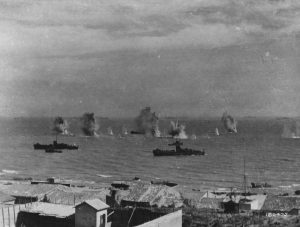
Combat for Gela beachhead, Sicily. The landing was performed in the face of Axis air superiority, a lesson well remembered for the Normandy invasion.
Once the beachhead was strong enough, the Fighting First fought its way through Sicily’s central heights up to Troina, where the Germans & Italians had established a major strongpoint. A first attempt to carry it off on July 31st by the 39th Infantry Regiment (from 9th Infantry Division, but temporarily attached to BRO) failed, forcing the Allies to mount a full-scale assault. The ensuing battle lasted for a week and cost the Allies dearly, as well as earned BRO its first (posthumously) WW2 Medal of Honor.
While Patton, Allen’s protector, was entangled in his “slapping affair“, Bradley took the failed initial assault at Troina as an excuse to finally relieve the hard-drinking, hard-swearing & unkempt Allen of his command. The day after the battle of Troina was over, he was replaced at the head of the 1st Infantry Division by general Clarence R. Huebner, himself a WW1 BRO veteran. Huebner’s task wasn’t an easy one: he was to replace a general loved by his men who had mirrored their behavior on his own and was specially instructed by Bradley to whip back some discipline into the unruly BRO.
NORMANDY
After the Sicily campaign, BRO was pulled out of the line and sent to Great Britain in November 1943, having been selected as one of the assault divisions for the planned Normandy landing. It was both a testimony to their unequaled experience in amphibious operations and an injustice to put once again the same unit in the line of fire. As exemplified by the British 7th Armoured & 51st Infantry Division during the Normandy campaign, asking too much even of an elite formation could lead to battle-weariness, and Bradley was well aware. Yet, as he commented: “Much as I dislike subjecting the 1st to still another landing, I felt that as a commander I had no other choice. (…) My job was to get ashore, establish a lodgment, and destroy the Germans. In the accomplishment of that mission, there was little room for the niceties of justice“.
Yet, despite BRO‘s experience and combat record, Huebner sent his veterans back to training camps, drilling them drop-dead, something they regarded as an insult to their skills and combat history… and didn’t help to improve the new commander’s popularity. The moral of the division reached an all-time low, yet Huebner persisted. And that might have been what saved the division from the fate of the aforementioned British Praetorians which were “law unto themselves” and “only obey those orders that suited them”: BRO was drilled back to humility by its new commander. Finally, moral and confidence were restored and, although Huebner never enjoyed the popularity of his predecessor (and veterans never hid the fact), he ended up being known as “The Coach“.
It is worth noting that the two other American assault divisions earmarked for D-Day, 4th & 29th Infantry Division, although inexperienced, were both led ashore by their respective division’s deputy commanders … both former BRO senior officers and trained under “Terrible Terry” Allen: Theodore Roosevelt Jr. for the 4th ID at Utah Beach, Norman Cota for the 29th ID at Omaha Beach. They were the only two generals to land with their assault troops on D-Day and both have been since recognized as a major factor in the success of their respective division’s mission.
On June 6th, elements from the green 29th ID were put under command of the more experienced BRO, and together they received the mission of securing a beachhead at Omaha Beach. Landing in the wake of air and naval bombardments and right behind amphibious tanks, the assault troops were expected to mostly mop up the shell-shocked second-rate troops defending the area. As we know today, it didn’t happen that way with both preliminary strikes failing to hit their targets or inflict any sensible casualties, and the well-trained 352. Infanterie-Division having replaced the 716. Infanterie-Division in many defensive positions facing the 1st & 29th ID assault waves. To make matter worse, all but two of the DD Shermans supporting BRO had been launched too far and sunk in the Channel, and many units were put ashore in the wrong place.
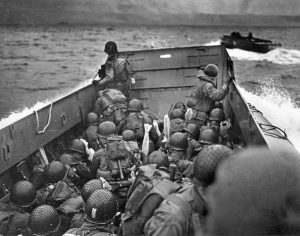
Approaching Omaha Beach
It was a literal slaughter, most of the men being shot at the door or within their landing craft. The first wave was wiped out, taking up to 50% casualties and unable to advance across the beach. In the most well-defended sectors, especially the one designated for the attached (and green) 116th Regiment from 29th ID, companies from the first waves lost all their officers and were down to about 25% of their initial strength in under 15mn.
The second and third waves coming behind them were equally pinned down. Casualties & chaos were rising while new reinforcement and vehicles were delivered on a beach full of dead, wounded and mixed up men from the Rangers, 1st & 29th ID hiding behind the shingle. With many officers dead or out of combat, it came down to junior officers, NCO or individual soldiers to take the lead and find a way out. Despite losses, small groups of men managed to reorganize under fire, infiltrate the German positions and advance inland. Yet, by mid-morning, the landing at Omaha started being regarded as a failure.
On BRO sector, or what was supposed to be, 16th Infantry Regiment‘s CO Colonel George Taylor started reorganizing combat groups regardless of their original units, putting any surviving officer or NCO in charge and sending them in the small gaps already created. To motivate his men to leave the protection of the shingle, Taylor famously claimed that “Two kinds of people are staying on this beach, the dead and those who are going to die – now let’s get the hell out of here!” (a quote wrongly attributed to Norman Cotta in The Longest Day). Soon, the gaps evolved into a breakthrough, and the assault troops poured inland.
BRO assault units suffered about 30% casualties, with those companies from the first wave paying the worst of the Butcher’s Bill. Yet the division was given no rest and had to expand the beachhead as fast as possible. From June 6th to 12th, the division performed a 23km advance inland, bringing it in front of the strategic crossroad at Caumont-l’Eventé. The next day, the weary American troops stormed and captured the city … but missed an opportunity to cut the German front in Normandy in two: faced with a mere token force (two recon companies!) from 2. Panzer, they didn’t push forward after securing their objective, allowing the rest of this elite German division to arrive and take position in front of them.
What kept BRO from pushing forward, aside from losses and combat weariness, was also that its advance had placed it in an exposed salient with both the British on its left and the US 2nd Infantry Division on its right being held back by stiff German resistance. Caumont was to be the link between US & British-Canadian sectors for the next two months and BRO & 2. Panzer were to become intimate foes.
1st Infantry Division was pulled out from Caumont in mid-July, given barely a week’s rest to refit and used as part of the breakthrough force in Operation Cobra. Attacking on July 26th, BRO & 2nd Armored Division captured Le Mesnil-Herman the next day and Marigny the day after. Securing the offensive’s left flank, BRO held Marigny against several counter-attacks from 2. SS-Panzer & 353. Infanterie Division.
AFTER NORMANDY
Although spared some of the hardest fighting for the rest of the Normandy campaign, BRO was nonetheless part of the pursuing force following the retreating German troops from Falaise to Northern France, and then to the Siegfried Line which it reached on September 16th, 1944. By October 1st, 70% of the men from 1st Infantry Division were replacements! After a mere two weeks training, they took part in the attack against Aachen, the first German city to be captured by the Allies and one of the fiercest urban battle ever fought by the US Army.
Immediately after the capture of Aachen, BRO was thrown into the Hurtgen Forrest’s meatgrinder. Finally pulled out and placed in reserve to refit in early December … it was only to be committed again in a hurry at the end of the month, to stall the German offensive in the Ardennes.
After the Battle of the Bulge, BRO advanced in Germany, then entered Czechoslovakia where it liberated the labor camp at Falkenau. It was still in this country on May 8th, 1945, when it learned about the German capitulation.
Among the first troops to be sent to Europe, the Fighting First had been through three major amphibious assaults, fought in deserts, mountains, beaches & cities and collected an unequaled tally of sixteen Medal of Honor over the course of the war.
THE BRO INGAME
A very infantry-centric division, BRO ranks among the very best ones the Allies fielded in Normandy.
Here are some of the 1st Infantry Division‘s features:
- RECON: this is BRO‘s main weak spot: as an assault division unleashed on a well-defended beach, there was no need for scouts to pinpoint the enemy! BRO has, therefore, no scout in phase A, but for some USAAF’s A-20C heavy recon planes. Recon (ground) troops are available from phase B.
- INF: BRO‘s finest! There isn’t a pack in its infantry tab without a star, and half of them have two. Besides, phase A troops are specially formed elite assault groups divided according to their role: Assault Leader, Assault Team, Assault MG & Assault Breachers with more strength than their regular counterparts (they were given extra-men in anticipation of losses) and extra assault equipment (TNT, smoke, flamethrowers, bazookas, …).
- TANK: most of BRO‘s amphibious tank support for D-Day ended up at the bottom of the Channel, hence tank support is pretty light in A, non-existent in B and finally arrive in C.
- SUPP: as an assault division, BRO was given a battalion of M7 Priest, including DD ones to be used as assault guns. Unlike other infantry division, it was also given a few half-tracks to be used as “light armor” or prime movers on the beach.
- AT: for most of the Normandy campaign, BRO received only towed AT battalions as attachment, hence 76mm AT guns but no Wolverines. But BRO‘s organic anti-tank guns (bazookas & AT 57mm) are also veteran or elite.
- AA: fearing Luftwaffe‘s interference during the landing, BRO brought Bofors guns on the beach in the first hours, with a few M15 & M16 to support and … tow them in the sand.
- ART: as an assault division, BRO received full support from the Navy. It can, therefore, count on off-map rocket artillery from phase A, as well as M7 Priest & naval artillery in later phases.
- Economy: BRO‘s economy is strong in A, doesn’t change in B and rise again somewhat in C.

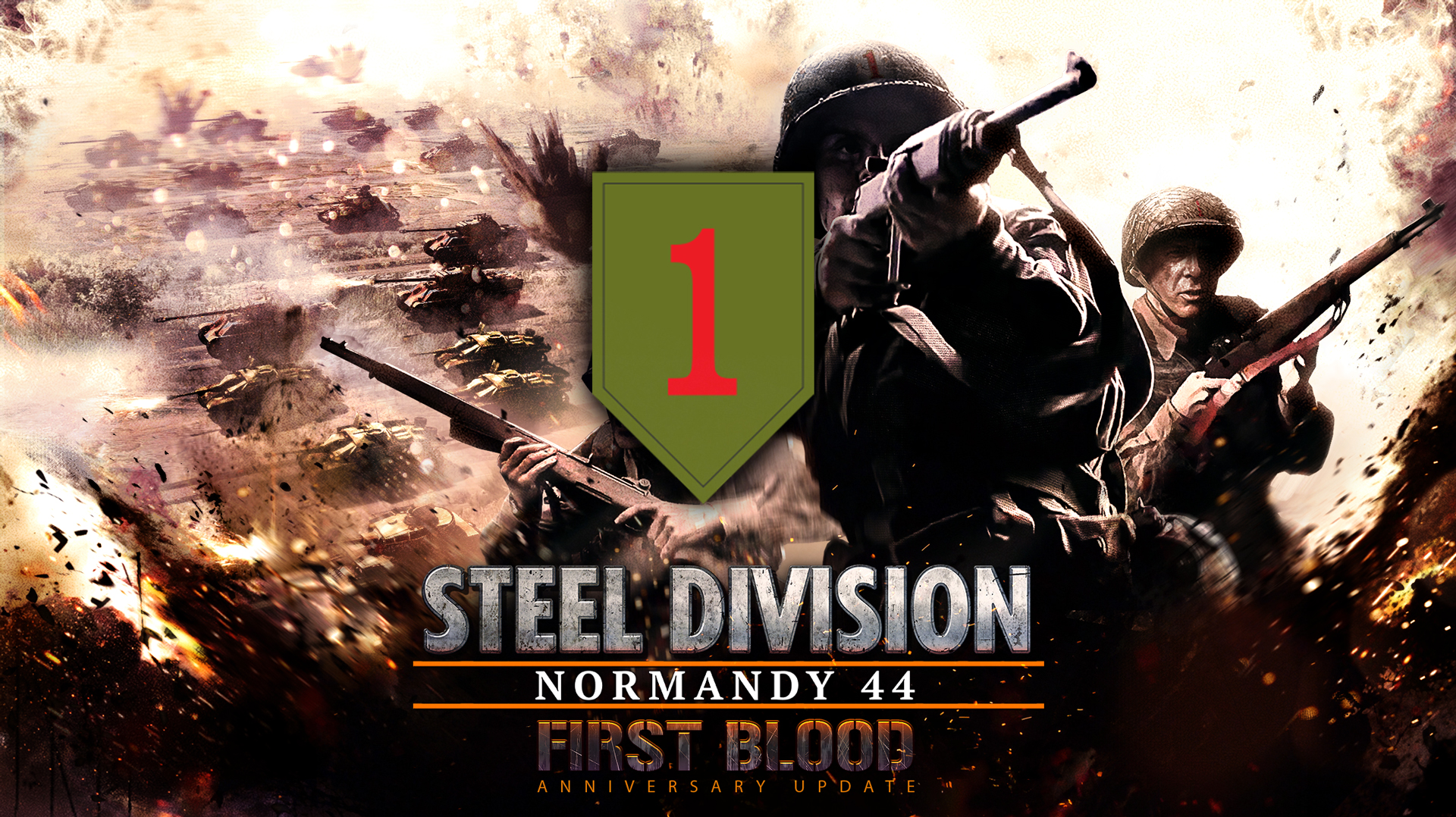



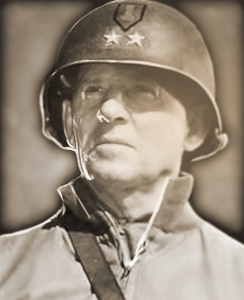
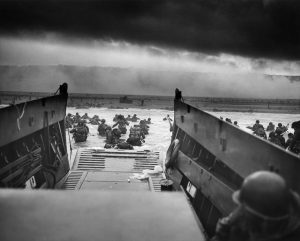
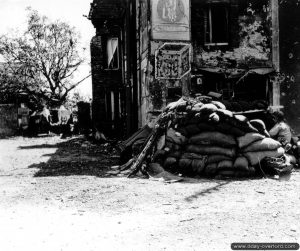
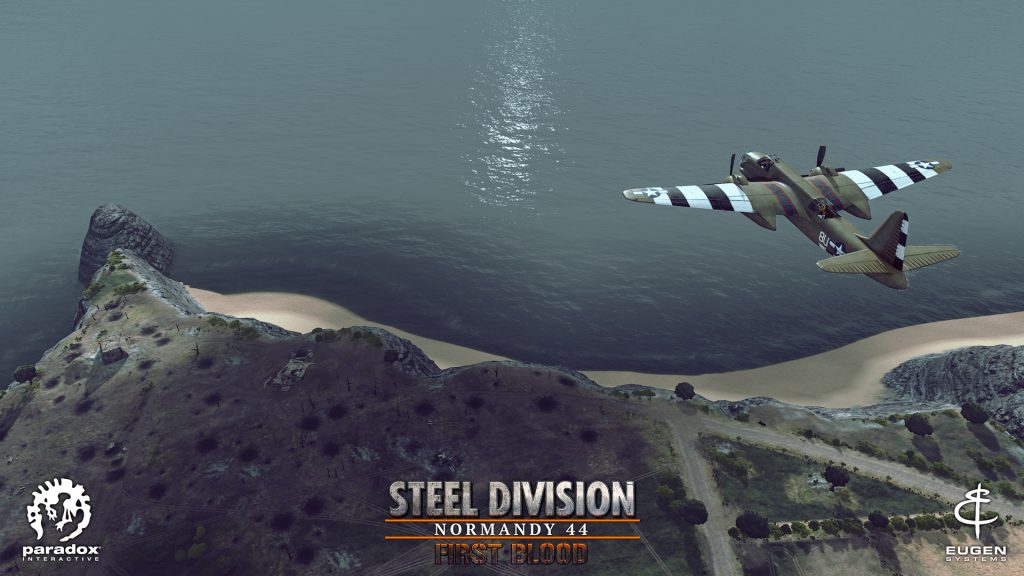


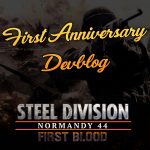
No Comments